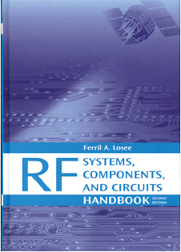
Phaselock Techniques, Third Edition
Wiley-Interscience • 447 pages; $84.95
ISBN: 0-471-43063-3
The first edition of this book was published in 1966 and the second in 1979. Phaselock was an unimaginably exotic subject in 1966, with limited applications and few practitioners. Now phaselocking is a mature subject. This book reexamines the traditional phaselock topics in greater depth than previously. In addition, much new material has been included, some of it never published. Examples of additions include revised and expanded material on transfer functions, two chapters related to phase noise, two chapters related to digital phaselock loops, a chapter on charge-pump phaselock loops, expanded material on phase detectors and a chapter on anomalous phaselocking. As in earlier editions, only minimal space has been devoted to circuits. The book is concerned with underlying principles, which remain valid despite technology advances, not with implementations, which change drastically as technology changes. Several parts of the second edition have been omitted: the chapters on optimization and synchronization, and the mathematical appendix. Formal optimization has not proved to be as important to design as was earlier anticipated; instead, a designer is much more likely to perform a trade-off among the few parameters available in a practical phaselock loop. The mathematical appendix has been omitted on the premise that the level of mathematics presented should be comfortable for all electrical engineering graduates. Synchronization, a major discipline of its own, was deemed to have grown too large to cover adequately in a book on phaselock loops. Simulation is another absent topic. Information presented in several chapters is based on simulation. Simulation is crucial for design and verification of integrated circuits. However, this topic is too extensive and deserves a separate book of its own.
To order this book, contact:
John Wiley & Sons Inc.
One Wiley Drive
Somerset, NJ 08875
(800) 225-5945

RF Systems, Components and Circuits Handbook, Second Edition
Artech House • 500 pages; $119, £68
ISBN: 1-59693-010-1
Since the first publication of this book, in 1997, there have been many changes in the RF field. The goal of this second edition is to add as much new material and to be as up-to-date as possible. It is organized in two parts. Part I, which comprises Chapters 1 through 10, covers RF systems. Important topics include telephone systems, wireless communication systems; global positioning systems (GPS); radar systems; radio frequency signal propagation; RF noise; signal modulation techniques; RF subsystems; modulators and demodulators; and block diagrams of communications systems.
Part II, which comprises Chapters 11 through 19, covers RF components and circuits. Important topics include transmission lines and transmission line devices; waveguides and waveguide-related systems; antennas; lumped constant components and circuits; RF transformer devices and circuits; piezoelectric, ferromagnetic and acoustic wave devices and circuits; semiconductor diodes and their circuits; bipolar and field-effect transistors and their circuits; and vacuum tubes and microwave tubes. An effort has been made to better consolidate subject material. For example, nearly all the material on telephone systems is found in Chapter 1 rather than in a number of chapters. Nearly all the material on radar is found in Chapter 4 rather than being disseminated in a number of chapters. Chapter 3 presents new material on global positioning satellite systems. Chapter 7 includes new material on direct-sequence spread spectrum systems and Chapter 13 includes new material on microstrip patch antennas. One way to make the book interesting and easy to understand is to make use of many illustrations and figures. In this second edition, there are 163 figures in Part I and 196 figures in Part II.
To order this book, contact:
Artech House
685 Canton St.
Norwood, MA 02062
(781) 769-9750 ext. 4030
or 46 Gillingham St.
London SW1V 1HH, UK
+44 (0) 207-8750
